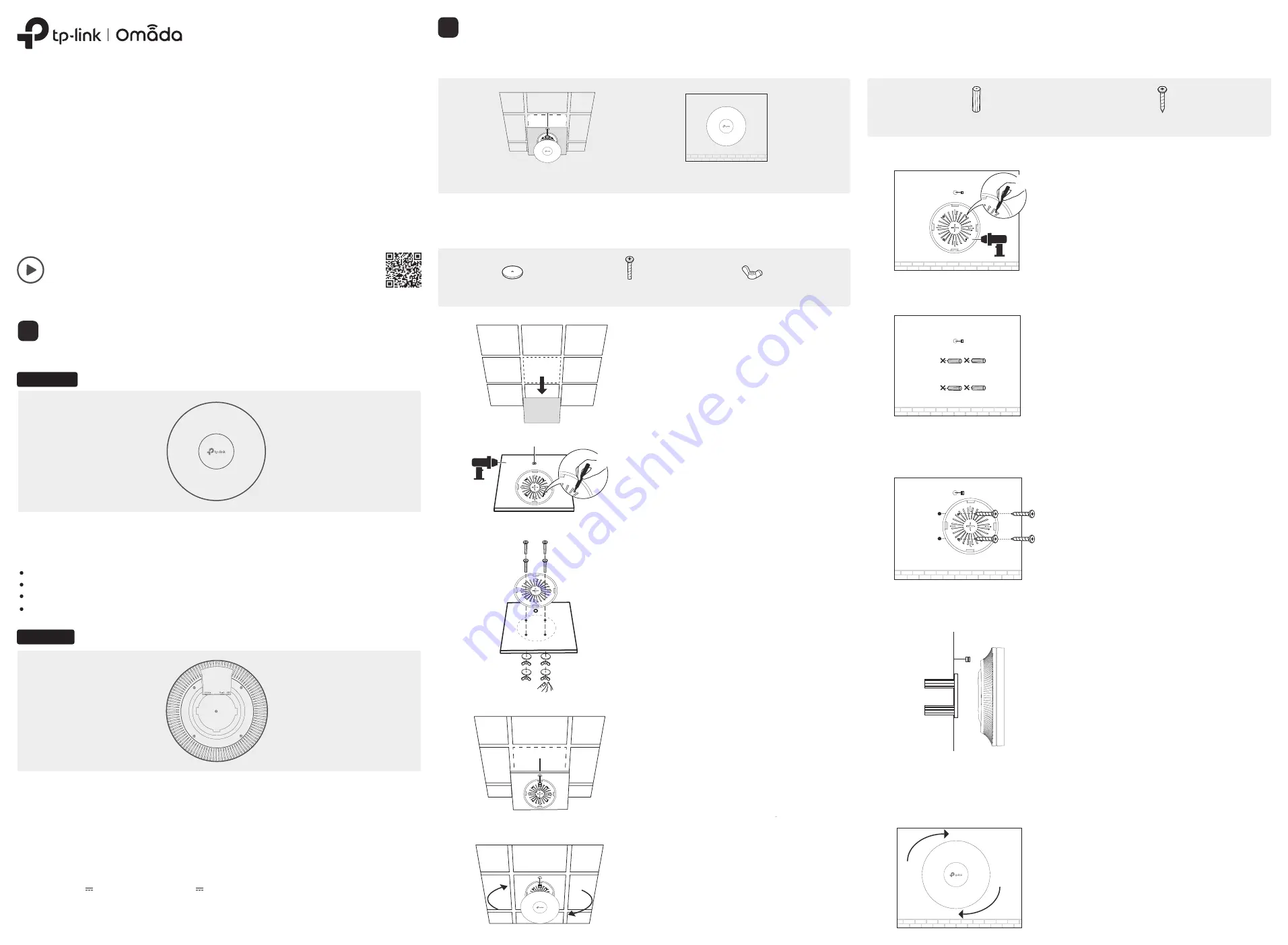
Quick Installation Guide
Wireless Access Point
Setup with videos
Visit https://www.tp-link.com/support/setup-video/ or scan the QR code to search for
the setup video of your product model.
Note
: For simplicity, we will take EAP660 HD for example throughout the Guide. The image may differ from the
actual product.
Hardware Overview
1
On:
Working normally/Initializing.
Off:
Working abnormally/Power off/LED is turned off.
Flashing:
Initialization
: The LED flashes twice after initialization is completed.
Upgrade
: The LED flashes once per second while upgrading.
Reset
: The LED flashes quickly during the reset. The EAP will then reboot.
Locate
: When the Locate feature is activated in the Omada controller, the LED flashes quickly to locate and
identify the device. The LED will flash for 10 minutes, or you can disable the feature manually to stop it flashing.
LED Indicator
RESET
With the device powered on, press and hold the button for about 5 seconds until the LED flashes quickly
. Then
release the button. The device will restore to factory default settings.
The port is used to connect to a router or a switch to transmit data, or to a PSE (Power Sourcing Equipment), such
as a PoE switch, for both data transmission and Power over Ethernet (PoE) through Ethernet cable. The port
supports transmission speed of 10/100/1000/2500 Mbps for EAP660 HD and 10/100/1000 Mbps for EAP620 HD.
Ethernet Port: 2.5G ETH (PoE)
(for EAP660 HD)
| ETH (PoE)
(for EAP620 HD)
Plug one end of the provided power adapter to this port and the other end to a standard electrical wall outlet to
power the EAP.
Power Port: 12V 2A
(for EAP660 HD)
| 12V 1A
(for EAP620 HD)
2
Insert the plastic wall anchors into the 6 mm
diameter holes.
4
Connect the Ethernet cable to the Ethernet port on
the EAP.
5
Attach the EAP to the mounting bracket, then
rotate the EAP until it locks into place, as shown on
the left.
M3×20 Self-tapping Screws (Qty.4)
M3×28 Plastic Wall Anchors (Qty.4)
1
If your Ethernet cable feeds through the wall, you
can position the mounting bracket below the cable
hole. Mark four positions for the screw holes and
then drill four 6 mm diameter holes at the marked
positions.
3
Secure the mounting bracket to the wall by driving
the self-tapping screws into the anchors. Make
sure that the shoulders of the mounting bracket are
on the outside.
1
Remove the ceiling tile.
2
Place the mounting bracket in the center of the
ceiling tile. Mark four positions for the screw
holes and a position for the Ethernet cable hole.
Drill four 4 mm diameter holes for the screws and
a 25 mm diameter hole for the Ethernet cable at
the marked positions.
3
Secure the mounting bracket to the ceiling tile
using four M3x30 pan-head screws, washers and
wing nuts, as shown on the left.
4
Feed the Ethernet cable through the hole and set
the ceiling tile back into place.
5
Connect the Ethernet cable to the Ethernet port.
Attach the EAP to the mounting bracket, then
rotate the EAP until it locks into place, as shown on
the left.
Note: Make sure that the ceiling tile is bigger than the EAP.
Wing Nuts (Qty.4)
Washers (Qty.4)
M3×30 Pan-head Screws (Qty.4)
The EAP can be ceiling-mounted or wall-mounted. Choose a mounting method according to your
needs. Follow the steps below for the appropriate installation.
Hardware Installation
2
Drill Hole for Ethernet cable
X4
X4
Front Panel
Rear Panel
Option 1: Ceiling Mounting
Option 2: Wall Mounting
Option1: Ceiling Mounting
Option2: Wall Mounting




















